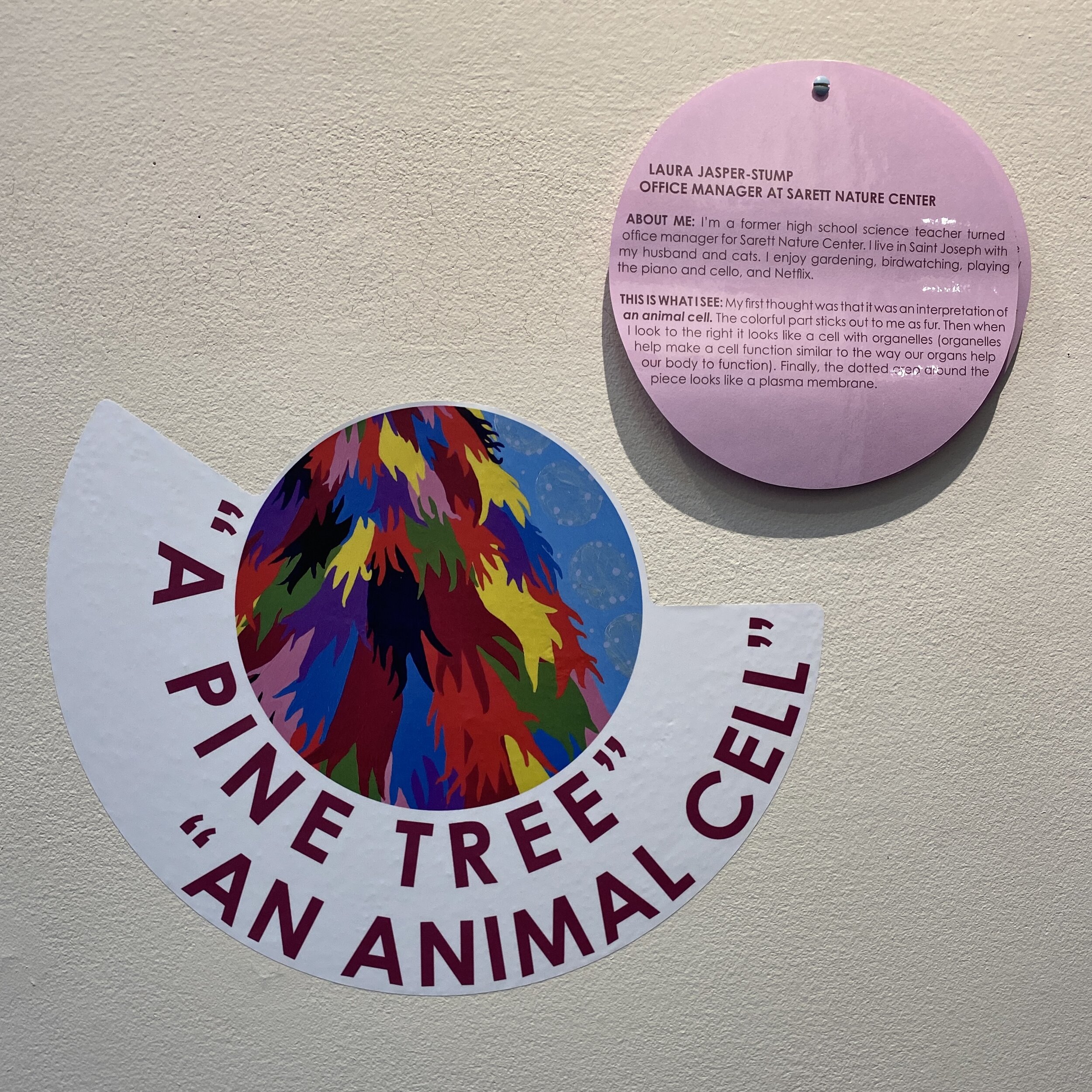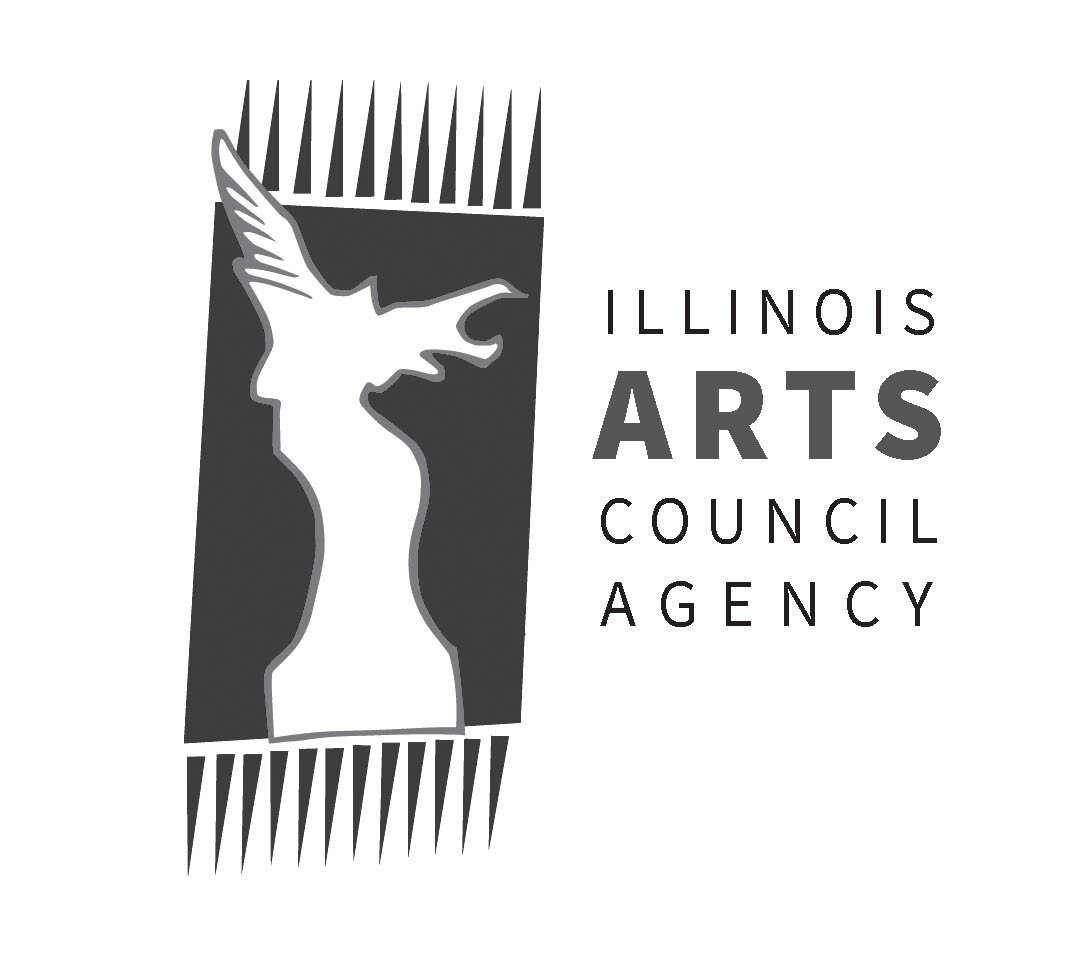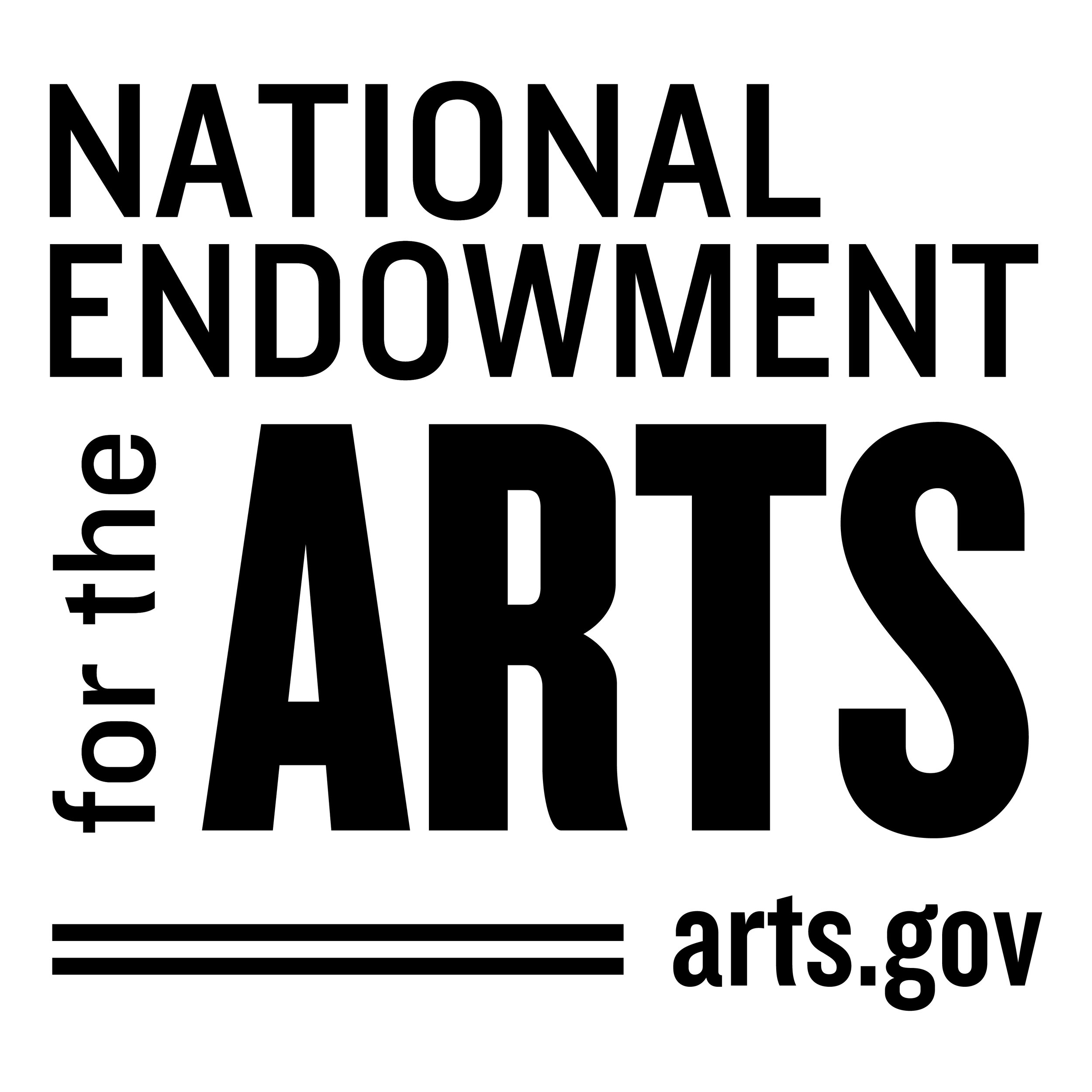WHAT DO YOU SEE?
NIKKI RENEE ANDERSON AND RENEE ROBBINS INVENT FANTASTICAL WORLDS THAT COMBINE REAL AND IMAGINED SUBJECTS. WE ASKED EXPERTS WITH DIFFERENT PERSPECTIVES TO TELL US WHAT THEY SEE WHEN THEY LOOK AT ARTWORKS FROM BOOM BLOOM. NOW IT’S YOUR TURN. GRAB A MAGNIFYING GLASS AND TAKE A CLOSER LOOK. WHAT DO YOU SEE WHEN YOU LOOK AT THESE WORKS OF ART? THE POSSIBILITIES ARE ENDLESS!
Outside label: “AN ANIMAL CELL” “A PINE TREE”
LAURA JASPER-STUMP, OFFICE MANAGER AT SARETT NATURE CENTER
ABOUT ME: I’m a former high school science teacher turned office manager for Sarett Nature Center. I live in Saint Joseph with my husband and cats. I enjoy gardening, birdwatching, playing the piano and cello, and Netflix.
THIS IS WHAT I SEE: My first thought was that it was an interpretation of an animal cell. The colorful part sticks out to me as fur. Then when I look to the right it looks like a cell with organelles (organelles help make a cell function similar to the way our organs help our body to function). Finally, the dotted area around the piece looks like a plasma membrane.
JULIET GOLOB, NATURALIST AT SARETT NATURE CENTER
ABOUT ME: I grew up in Stevensville and I have worked at Sarett since High School. I have a love for the arts that takes the form of musical theater and various mediums of hyper realistic nature/game graphics etc. including pencil, acrylics, watercolor, and digital. I spend my spare time doing small mammal wildlife rehabilitation and loving my two pets, my kitten Marnie and my rabbit Bowser.
THIS IS WHAT I SEE: I picture a beautiful winter pine tree with the shadow of the night sky. The first thing I noticed was the flared edges of every colored portion. The shape of each individual color looks like the outline of individual pine fronds coming together to make one large tree. The dotted outline behind like a shadow in the snow and the circles within are reminiscent of the phases of the moon.
Inside label: Renee Robbins, Butterfly Wings
Renee Robbins actually referenced microscopic images of butterfly scales as she was painting this artwork. Did you know that butterflies have scales similar to the scales of a fish or feathers of a bird?! If you have ever touched a butterfly wing, you might have seen the scales come off on your finger.
Robbins also studied bioluminescence (when living organisms like fish or mushrooms emit light) and - just as Laura observed - cells to create this painting!
Outside label: “ENERGY COURSING THROUGH TREES”
BENJAMIN FUTA, FOUNDER AND CEO, BOTANY LLC (botanyorbust.com)
ABOUT ME: I grew up gardening on the outskirts of South Bend, Indiana. What began as a hobby evolved into a professional calling and after a decade in botanical gardens I established Botany in 2018 as an outlet to explore new ideas and develop creative concepts related to the “culture” in horticulture. I graduated from Indiana University South Bend with a Bachelor's Degree of General Studies and Sustainability, with an Associate’s Degree in Interdisciplinary Agriculture from Purdue University. (Say that five times fast) Today I’m proud of my interdisciplinary background because I’ve finally embraced the fact I like to wear a lot of hats/shoes (see my closet for proof).
THIS IS WHAT I SEE: The first thing I notice is how my eye is drawn to the center of the piece, toward the light blue area that bisects the painting. It feels as though I’m looking out from a deep woodland toward an open meadow and river beyond. The bright and bold colors remind me of the energy coursing through trees, especially in spring, as pent up sugar stored in each tree’s roots begins to ascend to the buds above. While we may not see this action taking place, trees are bright and bold and energetic this time of year, and I feel those same feelings in this painting.
Inside label: Renee Robbins, Nightblooms, Moon-Lanterns, & Rockets
Have you thought about trees being energetic?! What if we could see all the behind-the-scenes processes of the forest?
As the title might hint, Robbins was inspired by both natural and manmade objects and processes to paint Nightblooms, Moon-Lanterns, & Rockets. She studied trees and grass, dragonfly wings, octopus suction cups, sea urchin, and bioluminescence as well as cilia, mitosis & cellular division. But she also drew from carnival ride paintings, LED lights and electronic lights.
Outside label:“THE OCEAN”,
JENNA FRANCIS, MIDDLE SCHOOL SCIENCE & ASTRONOMY TEACHER AND UPTON PLANETARIUM DIRECTOR
ABOUT ME: I've been teaching middle school for 20 years. I love teaching science and I love middle schoolers. I've been the director of the Upton Planetarium for 13 years. My dad was an Astronomy teacher at Lake Michigan College and my love for Astronomy came from him pointing out the constellations and telling me about the universe.
THIS IS WHAT I SEE: This painting reminds me of the ocean. The circles with the off-white figures inside make me think of baby octopuses. The yellow figure in the upper right reminds me of an anemone with flowing red tendrils. A lot of the other shapes remind me of coral. The dark blue background reminds me of the deep ocean.
Inside label: Renee Robbins, Moon Pollinators
Moon Pollinators is part of Robbins’ Crescent Zoom, a series of imagined worlds where you can “choose your own adventure!” Even though the final paintings are imagined compositions, Robbins did study real objects and processes to inspire each work - often combinations of many different things, some of which are from the ocean, like Jenna observed.
For Moon Pollinators, Robbins drew from bees, insects, and pollination. She also looked at tracheid cells (which transport water in vascular plants), succulents, praying mantis legs, jellyfish tentacles, and corals.
Outside label: “NUDIBRANCHS”
ANN ST. AMAND AQUATIC ECOLOGIST
ABOUT ME: I grew up in Florida, along the gulf coast. I'm the primary taxonomist at PhycoTech, and I teach all of our algal taxonomy workshops. I enjoy native and food gardening, reading, singing in a praise group, hiking, hunting for algae (and a billion other cool things, yes, a bit ADD) as well as hanging out with my awesome husband and kids, and grandsons Harry and Jayce!
THIS IS WHAT I SEE: Oh my God, this is AWESOME!!! I was drawn to the colors and as I was looking more closely, it seemed to me that many of the individual objects were actually marine or reef organisms, many of them nudibranchs and polyps! What I thought was a Nautilus, is something else I think, which I also love. I'm a science geek at heart, and this piece of art totally appealed to me! I really like the way the colors are integrated and when you stand back it almost looks like looking down on the Medusa of a Jellyfish, but looking closer you see all the intricate animals. I could swear there are some other things in there, like seaweed, corals and diatoms, but maybe that's because I want to see them. I like it for the same reason I'm drawn to gardening, I design my gardens to look one way from a distance, and differently from close up.
Inside label: Renee Robbins, Comma-Sized
Yes, Robbins did study nudibranchs to create Comma-Sized! But what’s a nudibranch? Nudibranchs are sea slugs, shell-less mollusks with jelly-like bodies that dwell along the bottom of the ocean. And they’re just as colorful in real life as they are in Robbins’s paintings!
Outside label: “MERINGUE”
MANDY KRAUSE, PASTRY CHEF, OWNER OF LOVE AND MACS (loveandmacarons.com)
ABOUT ME: Hi, I’m Mandy and I’m a Southwestern Michigan native! I graduated from the French pastry school in Chicago 10 years ago. I own a small business called love and macs, which just turned 3! I enjoy art, champagne, death metal.
THIS IS WHAT I SEE: The first thing I notice about this piece is the shape and shine! The spheres and peaks remind me of meringue. Meringue is made of sugar and egg whites and it’s a medium I use often. (You can find it on top of things like a lemon tart, or as a base for Macarons!) The contrast of the white meringue-inspired shape with the pools of pink highlights the similarity to treats! The pools of pink remind me of sauce on a plate, which I could easily see a lemon tart topped with meringue sitting on top.
Inside label: Nikki Renee Anderson, Standing Bodies
Like meringue, these sculptures are dripping, bulging, oozing, and expanding! Anderson referenced the human body as well as teardrops and fluid to create these arworks. She is particularly interested in the ways in which fluid flows from the body (like when we cry or bleed). The pieces relate to the idea of growth, multiplication and expansion.
Outside label: “FLOWER BULBS”
NELSON "THE ANIMAL GUY" PEARSON, DIRECTOR OF WILDLIFE SAFARI
ABOUT ME: Nelson "The Animal Guy" is a wildlife expert who works with exotic animals from around the world. Nelson's company is based in the Metro-Detroit area but travels all over Michigan and the surrounding states. In addition to working with animals, Nelson enjoys sculpting, painting, and creating digital art.
THIS IS WHAT I SEE: The organic shape and prickly texture of the sculpture reminds me of flower bulbs. The white could symbolize Winter or the unknown type of flower concealed within the bulb. The contrasting red color of the base highlights the sculpture's shape.
Inside label: Nikki Renee Anderson, Dribble Portraits
How do you feel when something new is about to happen? Excited? A little nervous? Probably not unlike waiting for a flower to bloom, The Dribble Portraits investigate the physical and psychological experiences of pregnancy and motherhood. The sculptures were conceived of and created during Anderson’s own early experiences of motherhood.
Outside label: “CARNIVOROUS PLANTS
JESSA CALDERWOOD, ANALYTICAL CHEMIST AT LECO CORPORATION
ABOUT ME: I grew up in St. Joe, left for college and grad school, and decided to return home. I work as a chemist and in my free time enjoy reading, gardening, hiking, camping, and - when we can find the time - backpacking.
THIS IS WHAT I SEE: The first thing I thought of with this painting is carnivorous plants. The vase-like shape, the "teeth" on the edge, and the bright, attractive inside to lure unsuspecting prey in. The swirls on the outside and the curvature also has an organic feel to it.
Inside label : Nikki Renee Anderson, Sugar Flora 3
Have you ever noticed that the names for furniture parts are a lot like the names of body parts? Chairs have arms and legs. Clocks have a face. And a vase has a neck. Anderson looked at antique furniture and objects from her grandmother’s and great-grandmother’s homes to create these sculptures, but they also relate to the human body, fruits, and flowers address transformation and confront ideas of femininity, intimacy and beauty stereotypes.
Outside label: “POCKETS OF GROWTH”
TASHA TURNER-FREEMAN, HEALTHCARE PROVIDER
ABOUT ME: I’m from Kalamazoo, MI, though I currently reside in the Metro Detroit area with my little family of 5. Professionally, I consider myself to be a bridge builder that works to bring together systems with the everyday people impacted by their presence. Mental health and wellness is my area of expertise and removing barriers is my passion.
THIS IS WHAT I SEE: I notice the pockets and groupings of what looks like buds, right away. It looks like pockets of growth that are also being confined to a small space. I notice all of the white and I wonder what would happen if the buds weren’t confined and instead had room to spread/grow? The large white space, the distinct solid boundaries, and the sunken nature of the yellow is what makes me think of these sectioned off spaces of growth.
Inside label: Nikki Renee Anderson, Sugar Blossom 3
Imagine taking off from a city in an airplane or zooming out on a town in Google maps. Can you picture the way the bunches of trees look from above? Sugar Blossom 3 is one of a series that explores growth (like Tasha suggested) through the idea of “the multiple.” Anderson imagined the artworks as tiny landscapes or maps.
CRESCENT ZOOM artworks are partially supported by a 2021 Individual Artist Support grant from the Illinois Arts Council Agency through federal funds provided by the National Endowment for the Arts.
CRESCENT ZOOM artworks are also partially supported by a 2021 Individual Artist Program Grant from the City of Chicago Department of Cultural Affairs & Special Events, as well as a grant from the Illinois Arts Council Agency, a state agency through federal funds provided by the National Endowment for the Arts.











